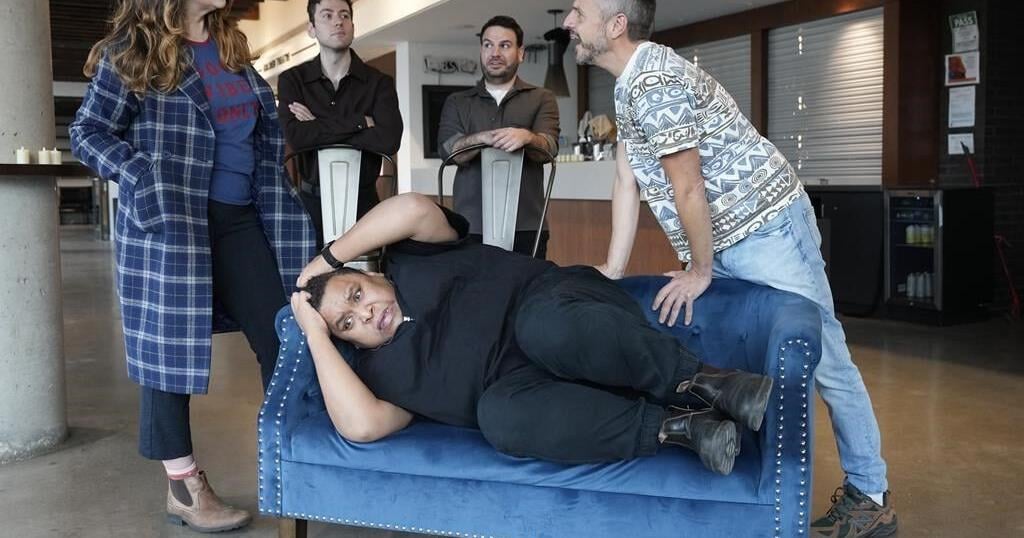TORONTO – During the pandemic, Michael Ross Albert grappled with a familiar kind of stress for many Torontonians: the uphill battle of trying to buy a home in the city.
“I remember walking out of the bank with the money order and thinking that I was holding in my hands probably more money than I might make in my lifetime,” recalls the Canadian playwright after buying his first condo.
“I was playing it cool and just pretending like this was totally a normal transaction. I got about four steps before I just puked all over Bay Street.”
With the average home price in the Greater Toronto Area expected to climb to $1.19 million by year’s end — a six per cent increase from 2023, per a new report by Royal LePage — Albert knows his experience resonates, given that home ownership feels out of reach for many.
So he’s channeled some of this real-estate tension into “The Bidding War,” a biting new comedy premiering Tuesday at Toronto’s Crow’s Theatre.
The play takes aim at Toronto’s housing crisis with a story set during a frantic, one-day bidding war over the city’s last affordable home. As the clock runs out, the fight for ownership devolves into chaos, laying bare the lengths to which people will go in their frantic quest for a foothold in the market.
Directed by Toronto’s Paolo Santalucia, the world premiere features an ensemble cast, including “Baroness Von Sketch Show” star Aurora Browne as savvy real-estate agent Blayne and “Letterkenny” star Gregory Walters as Charlie, one of the many buyers caught up in the madness.
Albert says he hopes “The Bidding War” exposes the “unfairness” of Toronto’s real estate system.
“I would love it to show that there is a different way we can imagine life, especially in this city, and that we don’t need to be in such brutal competition with one another over what is a basic human right,” says the rising playwright who garnered critical acclaim for his 2022 workplace comedy “The Huns.”
“We need to find a way to fix the housing crisis somehow, and hopefully laughing at it is a very good first step.”
Browne says she was excited to join the 11-person cast, which is “unusually large” for a Canadian production, given the costs of staging plays with big teams.
“Talk about a scarcity mindset — budgets for theatres have been getting squeezed and squeezed. I think we’re still feeling the pandemic just over our shoulders and being in a room with a lot of people doing something together feels so necessary. We’re all so alone in our problems these days.”
Browne says “The Bidding War” ultimately shows how self-serving those working in Toronto’s real estate market can be.
“Toronto is definitely a playground for people who are interested in their own profit,” she says.
Peter Fernandes, who portrays the home’s listing agent, says the production captures how the scarcity-driven nature of Toronto’s housing market exposes people’s “ugly sides.”
“It’s getting exponentially harder to live in the city and to make a life in it. If it keeps going in that direction, it’s just going to bring out some of the worst in people, and that could lead to more exploitation,” says the actor, who played the lead in “One Man, Two Guvnors” at this year’s Shaw Festival.
“I think the play is asking us to look at another avenue to grow as a city. There has to be another way so that it’s not so cutthroat.”
Like Albert, Santalucia became a homeowner during the pandemic. He says he felt rushed to buy a house during a time when prices were down.
“I just remember the bloodlust that rose in that period of talking to my partner and saying, ‘Whatever we need to do, we’ve got to do it because we’ve got two weeks to make the biggest financial decision of our lives.’”
That “manic” energy informed the direction of the play, which he says has moments of “bloody” violence and “physical, tawdry body humour.”
Santalucia believes the play underscores how humanity’s intrinsic desire to own things fuels the housing crisis, and he sees comedy as the most effective means of confronting that reality.
“Our inherent desire to conquer, our inherent desire to put a flag somewhere in the ground and call something ours — that’s the crisis. This play does a really amazing job at drawing attention to that fundamental aspect of our humanity,” he says.
“We hope that laughing at it might allow us to recognize it. And that’s going to be a little piece of the puzzle in how we fix it.”
“The Bidding War” plays at Toronto’s Crow’s Theatre until Dec. 15.
This report by The Canadian Press was first published Nov. 12, 2024.
